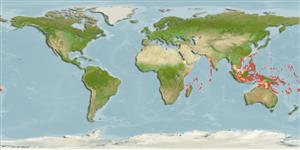>
Gobiiformes (Gobies) >
Gobiidae (Gobies) > Gobiinae
Etymology: Amblyeleotris: Greek, amblys = darkness + The name of a Nile fish, eleotris (Ref. 45335).
Environment: milieu / climate zone / depth range / distribution range
Ecología
marino asociado a arrecife; rango de profundidad 5 - 40 m (Ref. 48637), usually 5 - 15 m (Ref. 27115). Tropical; 21°C - 30°C (Ref. 27115); 30°N - 22°S
Indo-Pacific: East Africa to Fiji, north to southern Japan, south to the Great Barrier Reef.
Tamaño / Peso / Age
Maturity: Lm ? range ? - ? cm
Max length : 10.0 cm SL macho / no sexado; (Ref. 48637)
Short description
Claves de identificación | Morfología | Morfometría
Espinas dorsales (total) : 7; Radios blandos dorsales (total) : 12; Espinas anales: 1; Radios blandos anales: 12. Characterized by whitish to pale yellow body color with seven reddish brown to red bars; head and body with blue spots and sometimes on median fins; scattered red spots on head including corner of mouth; medially united pelvic fins for nearly half length of fifth ray; predorsal scales extending forward to above posterior margin of preopercle; longitudinal scale series 50-58; greatest depth of body 4.5-5.2 in SL; rounded caudal fin, slightly longer than head (Ref. 90102).
Apparently the most common shallow-water species of the genus found in coral reef areas, but may occur at depths greater than 30 m. Usually found in rubble areas near or within coral reefs and in symbiotic association with alpheid shrimps, most often with Alpheus ochrostriatus. Found in coastal sand slopes and deep lagoons, shallow to 40 meters depth range (Ref. 48637).
Life cycle and mating behavior
Maturities | Reproducción | Spawnings | Egg(s) | Fecundities | Larva
Randall, J.E. and M. Goren, 1993. A review of the gobioid fishes of the Maldives. Ichthyol. Bull. J.L.B. Smith Inst. Ichthyol. (58):1-37, 5 pls. (Ref. 9360)
IUCN Red List Status (Ref. 130435)
Threat to humans
Harmless
Human uses
Pesquerías: comercial; Acuario: Comercial
Herramientas
Special reports
Download XML
Fuentes de Internet
Estimates based on models
Preferred temperature (Ref.
123201): 25.5 - 29.3, mean 28.4 °C (based on 2297 cells).
Phylogenetic diversity index (Ref.
82804): PD
50 = 0.5000 [Uniqueness, from 0.5 = low to 2.0 = high].
Bayesian length-weight: a=0.00708 (0.00333 - 0.01504), b=3.09 (2.92 - 3.26), in cm total length, based on LWR estimates for this (Sub)family-body shape (Ref.
93245).
Nivel trófico (Ref.
69278): 3.4 ±0.4 se; based on size and trophs of closest relatives
Resiliencia (Ref.
120179): Alto, población duplicada en un tiempo mínimo inferior a 15 meses (Preliminary K or Fecundity.).
Fishing Vulnerability (Ref.
59153): Low vulnerability (10 of 100).
Nutrients (Ref.
124155): Calcium = 130 [58, 246] mg/100g; Iron = 0.739 [0.375, 1.425] mg/100g; Protein = 17.9 [15.9, 19.6] %; Omega3 = 0.0966 [, ] g/100g; Selenium = 25.8 [12.0, 56.8] μg/100g; VitaminA = 134 [36, 463] μg/100g; Zinc = 1.98 [1.28, 2.94] mg/100g (wet weight);
